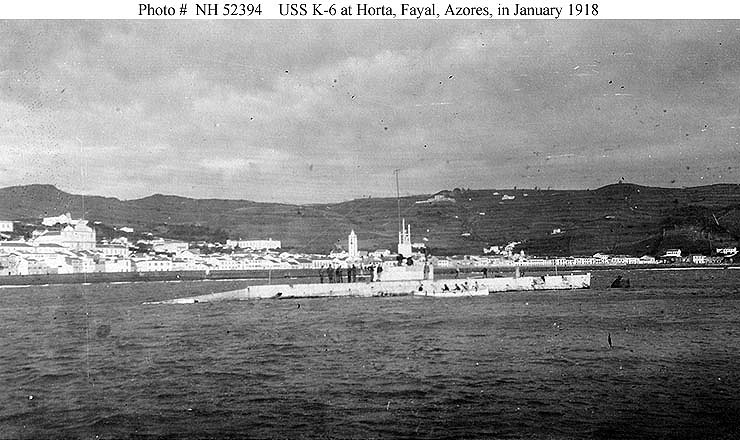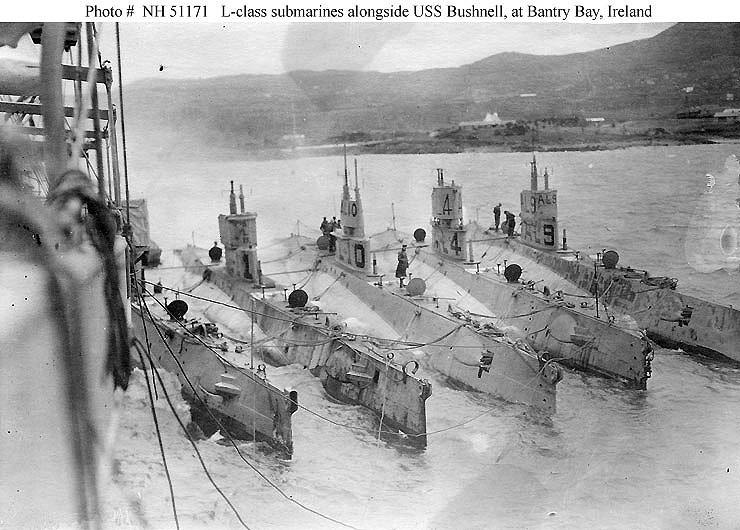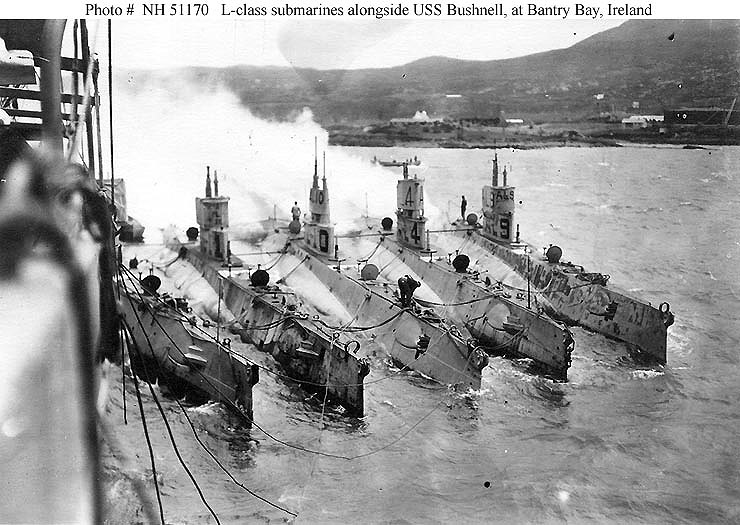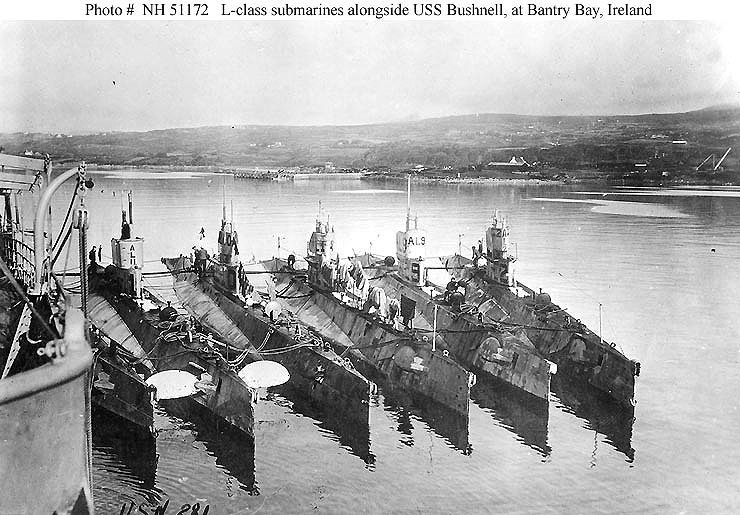Deployments - World War One |
| |
| During the first years of "The Great War" (it was not called World War One until the second world wide conflict erupted in 1938/1941) the United States persued a policy of isolationism based mainly on the Monroe Doctrine. There were two events that finally changed the United States popular opinion - and the outcome of the war: Unrestricted Submarine Warfare: because of it's stealth nature - in the early days of Submarine Warfare it was considered only proper that when a submarine was going to attack another vessel - that it notify the vessel - allow the crew to disembark then get on with it's attack. This form of restricted submarine warfare was only occasionally observed - and usually only when the political and propaganda benefits out-weighed other considerations. Unrestricted submarine warfare is when a submarine makes it's attack without warning - without mercy. The consequences are obvious -especailly when the target is an "unarmed" merchant man - or even worse - a passenger ship. Such were the circumstances during the middle of World War One - Germany exercised restricted submarine warfare - in order to appear less threatening to the United States - whom Germany did not want to become involved in the war. Howver - when things started turning against Germany - and te United States "help" to England became more and more overt and threatening to German interests - Germany resumed unrestricted submarine warfare. Since the United States had maintained "neutrality" in spite of several "bruisings" by German action - Germany became convinced that the benefits of resuming unrestricted submarine warfare were worth the risk - they felt the United States would "turn a blind eye". The Zimmermann Telegram: Germany was afraid of the United States industrial might - and wanted to do everything it could to keep the U. S. out of the war. In one of the most bone-headed stunts of the war - Germany sent a telegram to it's ambassador to Mexico offering to support Mexico with funds, munitions, tactics, etc. if Mexico would wage war against the United States. As futher incentive - Germany offered to give back to Mexico the territories lost to the United States in the Mexican / American War of 1846 - 1848. Mexico never seriously considered the offer - however - the British had intercepted the telegram - and sent it along to diplomats in the United States who made the telegram public. Rather than denying the authenticity of the telegram - Zimmermann confirmed it's validity - twice -- much to the horror and ire of the United States citizens. When Germany resumed it's exercise of unrestricted Submarine Warefare - along with the population's fears and ire over the Zimmerman Telegram - the United States declared war on Germany. The Zimmerman telegram was the document by which Germany proposed an alliance against the United States in which Germany would continue to "appear" neutral with regards to the United States - while supporting (financially, munitions and tactics, etc.) an invasion of the United States by Mexico. At the time - the United States Submarine force was still considered as a weak asset by much of the military as well as congress - with the result that the force had not benefited from the investments in funds, facilities including research that other countries submarine forces had - particularly Germany. So while the German "Unterseeboot " or U-boats served as formidable and effective offensive weapons - the United States Submarine force was still largely relegated to coastal patrol and defense of homeland waters. The United States' initial contribution to World War One Submarine "power" in Europe was to deploy a division (SUBDIV 4) of submaines to the Azores - K-1, K-2, K-5, and K-6 with their tender USS Bushnell (AS 2) The four submarines left New York and Philadelphia to attempt the crossing to the Azores. However - engine and fuel problems soon proved that course to be untennable - making it only so far as Provincetown, Massachesetts. From there Bushnelll and USS Chicago towed them to Halifax - then on to the Azores. The Tender USS Tonopah (BM 8) acted as tender to the 4th Division at the Azores - where they spent the rest of the war - mostly trying to repair their balky engines - and making a few patrols - with no enemy contacts. Bushnell returned to the states. |
 |
| K6 preparing for patrol during World War One. |
| | Submarine Division 5 which consisted of USS L1, L2, L3, L4, L9, L10 and L11 was sent to Bantry Bay, Ireland. After the problems with the 4th Division - it was decided the L boats (and E-1) would be towed from the start at Boston - the task being undertaken by USS Bushnell and two sea going tugs. A late season Atlantic hurricane soon hit the convoy - and made continued progress towards the Azores impossible - so the convoy turned south towards Bermuda. While badly shaken - and one tug and submarine forced to return to Boston - the rest of the convoy proceeded on to Ponta Delgada - arriving there on 7 January 1918. Bushnell and one seagoing tug towing two submarines each soon departed for Bantry Bay arriving there on 27 January, 1918. Three more class "L"s soon arrived - and all were "re-designated" "AL" boats (American L) to avoid confusion with the British "L" boats. These boats were utilized as "spotter" boats - patrolling the waters south of Ireland and west of England. Their primary responsibility was to patrol during the day at periscope depth looking for German U-Boats - and then patrol at night - recharging batteries - looking for German U-boats and other threats around the western approaches to the English Channel. . |
 |
| Note the "re-designation" numbers painted at the top of the sails. The last thing these boats needed was to be mis-identified by a surface ship as a German U-Boat "masquerading" as a British boat - and be fired upon by "friendly forces". |
| |
 |
| L boats firing up their primitive diesels. Holy smoke! |
| |
| Fortunately - the L boats were more reliable than the K boats - so they did their fair share of patrols - at any given time - three of the seven Ls were on 8 day patrols - while the other four were being refit and crews trained and rested. Keep in mind - these boats had no heat - when they arrived it was January - and the inside of the boats were the temperature of the sea they were in - the Atlantic in winter. The conditions were nasty at best - and down-right hazzardous most of the time. The air was foul from cooking, engine oil and by products, human - ah - well there weren't any showers - and after an 8 day patrol - you can imagine. The tenders did their best to provide relief and rehabilitation for the crews while the boats were along side. And as was common in these early days of the United States Submarine Forces - it was the Tender that not only allowed the submarines to be deployed where needed - it was as often as not the Tender that got them there in the first place. At the start of World War One - the United States only had 29 submarines in commision - most of which were on patrol in the Pacific - or Panama. With Twelve assigned to Europe - that left precious few for coastal patrol of United States waters - and with the increasing threat from the east - the Altantic coast was more and more vulnerable. As most of the "traditional" fleet was sent to help bolster the defense of England and the convoys of supply ships - the United States was forced to rely more and more on it's submarine force. Divisions were shifted from Hawaii and Puget Sound to the Atlantic coast and the United States embarked on an ASW (Anti-submarine Warfare) learning campaign that continues to this day. Those submarines - along with newer submarines as they were built - were divided into smaller divisions which were deployed from Provincetown, New London (tended by Fulton AS 1), Cape May, the Delaware Breakwater (near Cape Henlopen), Philadelphia, Hampton Roads, Charleston (tended by Rainbow AS 7), Key West (tended by USS Cheyenne), Galveston, the Virgin Islands, Bermuda (Alert AS 4), and Coco Solo in the Canal Zone (tended by Tallahassee) - trying to form a perimeter of protection for United States ports and coastal assets. However - as primative as the United States Submarines were - the U.S.'s ASW tactics were even worse - and German long-range submarines quickly racked up over 100,000 tons of shipping losses - mostly due to submarine laid mines - around the entrances to both the Chesapeake and Delaware Bays, New Jersey and Cape Hatteras. Unfortunately for Germany - and fortunately for the United States - these sucesses by the German U-boats came too little and too late to effect the outcome of the war. |
 | More "AL" boats - notice the retractable bow planes that are extended on AL 11 |
| |
| By the end of the war - the United States Submarine Force consisted of 74 submarines in service, with nearly as many under construction. The greatest benefit to the United States was the very real and painfully learned lessons about the viability of submarines as an offensive asset.because of this - the United States moved quickly forward with thier submarine design, testing and building programs - so that by the mid 30's the United States Submarine force could be counted among the best in the world. Which was fortunate- as World War Two came hard and fast... Note: much of this page is based on research by Dr. Ed Whitman, Senior Editor Undersea Warfare magazine. See the Spring 2004 issue of UnderSea Warfare for more of Dr. Whitman's work on this subject. |
| |
| Go Back to Deployments - Norfolk | Continue on to Deployments - PNS Portsmouth |
| Return to TenderTale Main Page © 2006 Common Cents Computers | |